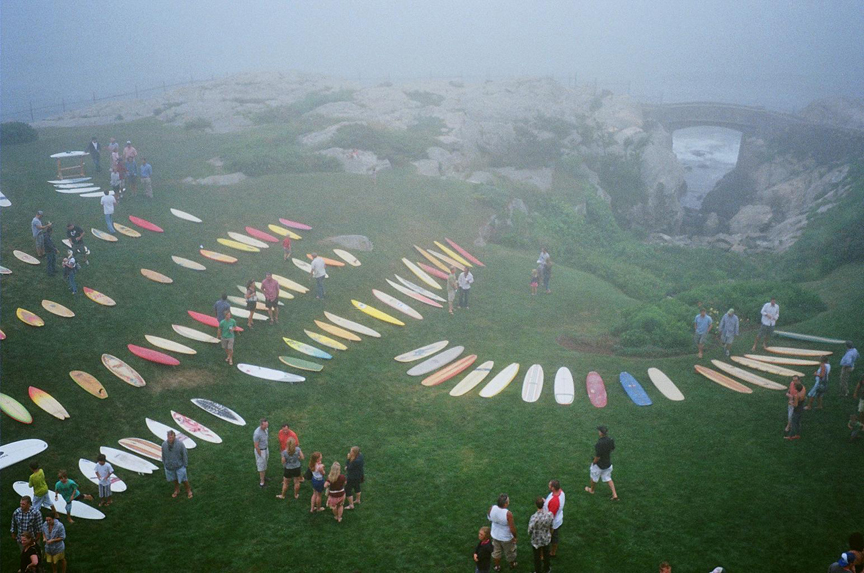“Surf-riding was one of the most exciting and noble sports known to the Hawaiians, practiced equally by king, chief and commoner. It is still to some extent engaged in, though not as formerly, when it was not uncommon for a whole community, including both sexes, and all ages, to sport and frolic in the ocean the livelong day.” (Malo)
By 1779, riding waves lying down or standing on long, hardwood surfboards was an integral part of Hawaiian culture. Surfboard riding was as layered into the society, religion and myth of the islands as baseball is to the modern United States.
Even the missionaries surfed.
Amos Cooke, who arrived in Hawaiʻi in 1837 – and was later appointed by King Kamehameha III to teach the young royalty in the Chief’s Childrens’ School – surfed himself (with his sons) and enjoyed going to the beach in the afternoon. “After dinner Auhea went with me, & the boys to bathe in the sea, & I tried riding on the surf. To day I have felt quite lame from it.” (Cooke)
Mark Twain sailed to the Hawaiian Islands and tried surfing, describing his 1866 experience in his book Roughing It. “I tried surf-bathing once, subsequently, but made a failure of it. I got the board placed right, and at the right moment, too; but missed the connection myself.”
“The board struck the shore in three quarters of a second, without any cargo, and I struck the bottom about the same time, with a couple of barrels of water in me.”
Missionary Hiram Bingham, noted of surfing (rather poetically,) “On a calm and bright summer’s day, the wide ocean and foaming surf … the green tufts of elegant fronds on the tall cocoanut trunks, nodding and waving, like graceful plumes, in the refreshing breeze …”
“… the natives … riding more rapidly and proudly on their surf-boards, on the front of foaming surges … give life and interest to the scenery.”
Although everyone, including women and children, surfed, it was the chiefs who dominated the sport. One of the best among Waikīkī’s chiefs was Kalamakua; he came from a long ancestry of champion surfers whose knowledge, skill and mana were handed down and passed on from generation to generation. (DLNR)
A notable wahine (woman) surfer was Kelea, sister of Kawao, King of Maui (about AD 1445) – “No sport was to her so enticing as a battle with the waves.” (Kalākaua)
She loved the water possibly because she could see her fair face mirrored in it – and became the most graceful and daring surf-swimmer in the kingdom. Kelea later married Kalamakua. (Kalākaua) But this story is not about Kelea.
This story is about another surfer girl.
Reportedly, Mrs James Cromwell became the first woman to take up competition surfing under the guidance of surfing champion and Olympic swimmer Duke Kahanamoku and his brothers.
Cromwell won “First Place” in a surfboard regatta staged at Waikīkī Beach (January 22, 1939.) She and beach boy Sam Kahanamoku won the tandem, open “malihini girls and beach boys” quarter-mile sprint. (Honolulu Advertiser, January 23, 1939)
She and Sam were a familiar team in Waikīkī, where they won tandem surfing and paddling competitions. A bronze medalist in the 100-meter free-style swim at the 1924 Olympics, Sam was also an avid surfer, paddler, musician and a great wit. (Their friendship continued until his death in 1966.)
By 1941, Cromwell had 13-boards in the household inventory. Each of the boards had a name or initials, including one named Lahilahi (thin or dainty,) an affectionate nickname given to her by the Kahanamokus.
All was not fun and games. Showing her husband her surfing skill while in Honolulu, Mrs Cromwell, in 1935, had a slight scalp wound as a result of being thrown from her 60-pound surfboard. An emergency hospital record showed she was treated and released. (St Petersburg Times, November 3, 1935)
She later had a more modern board, created by Dale Velzy, who is considered one of the men responsible for the rise of the California surfer culture in the years following World War II. Some suggest Velzy opened the first conventional surf shop at Manhattan Beach in California in 1949.
Her board is one of the first boards Velzy created using the new polyurethane foam material; boards were previously made of balsa wood.
Oh, by the way … Mrs Cromwell was more generally known as “the richest girl in the world,” Doris Duke.
Doris Duke, the only child of James Buchanan Duke, was born on November 22, 1912. Her father was a founder of the American Tobacco Company and the Duke Power Company, as well as a benefactor of Duke University. When Mr Duke died in 1925, he left his 12-year old daughter an estate estimated at $80-million.
In the late-1930s, Doris Duke built her Honolulu home, Shangri La, on 5-acres overlooking the Pacific Ocean and Diamond Head. Shangri La incorporates architectural features from the Islamic world and houses Duke’s extensive collection of Islamic art, which she assembled for nearly 60-years.
Her surfing legacy lives on.
Rough Point has been the ‘home’ of the Doris Duke Surf Fest. It’s not really a surf contest; it’s more of a display of vintage surfboards on the grounds of Rough Point, one of Duke’s other homes (in Newport, Rhode Island, not far from the International Tennis Hall of Fame.)
Designed in the English manorial style, Rough Point was originally built for Frederick W Vanderbilt, sixth son of William H Vanderbilt. When it was commissioned in 1887, Rough Point was the largest house that the Newport summer colony had yet seen, replacing two wood-frame houses at the extreme southeast end of Bellevue Avenue.
Duke’s father bought it in 1922. On her death, she bequeathed the estate to the Newport Restoration Foundation with the directive that it be opened to the public as a museum (it opened for tours in 2000.) (Lots of information here from Shangri La Hawaiʻi and Newport Restoration Foundation.)
























































